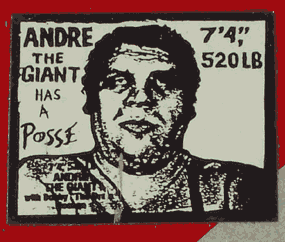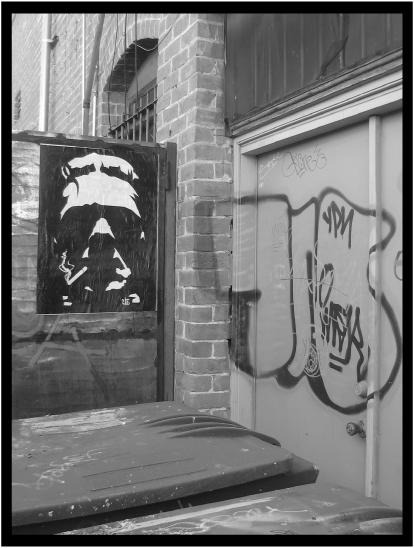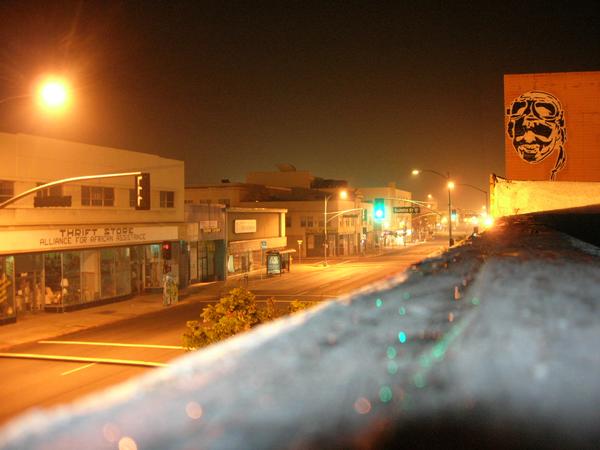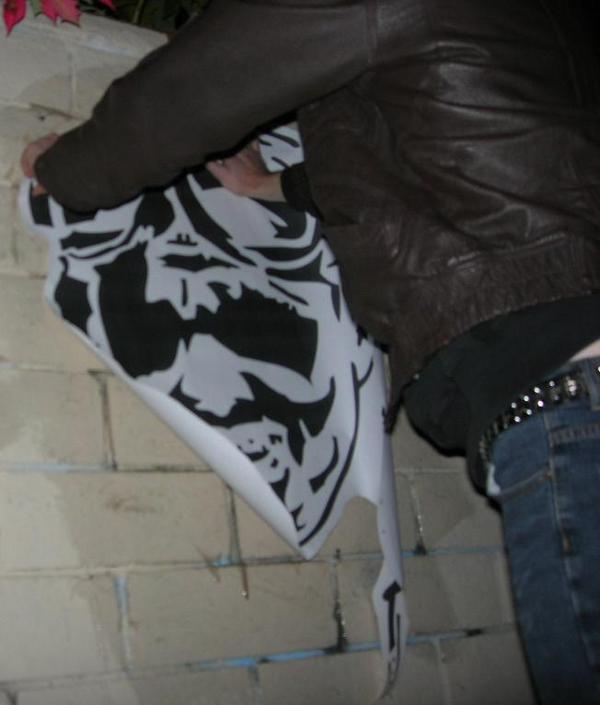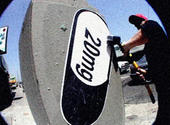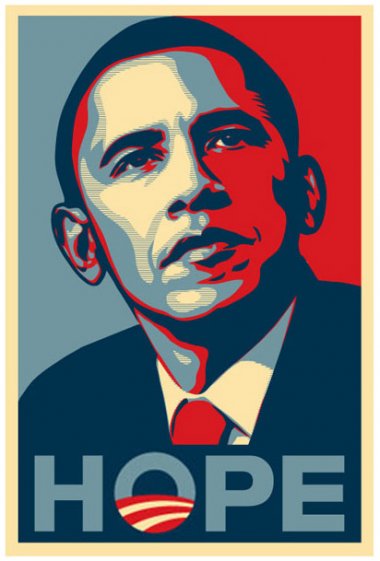Thanks to grad student Ryan Goode for contributing the following article. Ryan received his BA from UC Berkeley and his MA from Cal State Long Beach and is now in the SDSU – UCSB Joint Doctoral Program. His MA thesis was titled “The Politics of Pasting: A Spatial Inquiry into the Practice(s) of Wheatpasting, Power, and Representation.”
Before Obama, there was Andre. Before the rallies, there were the streets. Before it all made sense, it simply didn’t.
If you’ve paid attention to the 2008 presidential election, you probably recognize the two-toned iconographic image of recently elected President Obama pictured at the right. What you may not have known is that the man responsible for creating the image, Sheppard Fairey, also happens to be a world renowned street artist. Fairey is credited with popularizing a particular medium of street art known as wheatpasting. Generally speaking, practitioners of the medium create their own stylized posters and illegally affix them to highly visible spaces such as bridges, billboards, and electric boxes. The iconographic image on the poster is oftentimes equal parts vague and cryptic, designed to elicit a “what the heck is that” and “why is it there” response from the unsuspecting passersby. For the last three years, I’ve been researching a group of these street artists to find out what motivates them to produce their art. One thing I immediately learned was the important legacy of Sheppard Fairey.
As a student at Rhode Island School of Design in 1989, Fairey began to put stickers of former wrestler Andre the Giant’s face in and around Providence with the words “Andre has a Posse” written ominously to the side. The Andre sticker was designed to mock local skateboarding cliques and quite literally had no actual meaning. However, those who repeatedly encountered the image in public space began to speculate on their own as to what the mysterious stickers might mean. The reactions to Andre were so wide-ranging and, at times, ridiculous that Fairey began to ponder the psycho-geographical implications of his sticker. The image, Fairey now believed, functioned as a Rorschach test gauging his audience’s sensibilities. For example, the paranoid or conservative viewer might see Andre as threatening or imposing, while many others might see the same image as playful and humorous. Feeling compelled to broaden his ‘experiment,’ Fairey decided to introduce Andre (now in poster form) to large cities across the world.
As Andre’s physical reach began to broaden, so did the philosophical underpinnings of the campaign. When his posters began to be routinely condemned by authorities, it became apparent to Fairey that access to visual space was by no means democratic or based on aesthetics. Why was it that his nonsensical yet proactive posters created such an uproar, while the thousands of commercial images and billboards displayed in public space did not? As Fairey put it: “It’s about the use of public space and the dynamics of public space, about what was allowed and what wasn’t allowed. The criteria wasn’t necessarily aesthetic…more about what facilitated commerce and what didn’t, not what looked good.”
The geographical importance of Andre lies in its potential to raise the type of questions posed by Fairey above. Why did so many people find Andre to be ‘out of place?’ Why do these artistic posters draw so much attention, while unsightly billboards blend right in as a natural part of our urban landscape? What underlying ideologies concerning the role of public space could be responsible? After years and years of posing these questions, one poster at a time, Fairey has become a bona fide underground urban hero, not to mention the focus of numerous independent and mainstream media stories. As his art inevitably creeps further into popular consciousness, remember: before Obama, there was Andre. And Andre had something to say.
As for my own research, I wanted to get an idea of what motivated the most recent generation of poster artists. Why were so many of them risking life and limb climbing freeway overpasses, billboards, and bridges all to paste a seemingly nonsensical poster that few will notice let alone understand? Although inspired by Fairey, each of the artists I interviewed had their own personal motives which oftentimes varied significantly from one to the next. One thing they each held in common was a desire to creatively express themselves in public spaces- a right many of the artists believe is being actively suppressed in municipal codes across the nation. For some, using posters is the most democratic, safe, and accessible option amongst common alternatives for spatial-artistic expression, such as commissioned public art, murals, and graffiti. Opportunities for commissioned murals and public art pieces are scarce, while graffiti’s rather illegible nature and association with “vandalism” (and, therefore, not “art”) proved to be an undesirable alternative in the context of connecting with audiences. If anything, a lack of democratically accessible ‘creative space,’ seems to be one of the more enduring themes spanning from Fairey’s initial work to many of today’s contemporary poster artists.
I’ve also become interested in the relationship between the city of Los Angeles and its poster artists. Los Angeles is oftentimes imagined as a fragmented, largely privatized, and radically de-centered urban composition engendering a decidedly anti-pedestrian maze of freeways and suburbs. Perhaps, not surprisingly, the city’s physical and cognitive disjointedness has become a muse for poster artists. The L.A. based artists I interviewed cited isolation, overly hygienic suburban spaces, and the evolution of the freeway system into a de-facto public space for Angelinos as being tied to the development of their art. Postering, I argue, fosters an emotive connection to a city (and its people) that is infamously Balkanized along racial, economic, and cultural lines. The struggle to overcome urban alienation in the sprawling dreamscape that is contemporary L.A. has, interestingly, found a voice in the series of anonymous posters dotting the city’s landscape. Emile Durkheim, meet Sheppard Fairey.
Editor’s Note: Émile Durkheim, 1858-1917 was a French sociologist whose contributions were instrumental in the formation of sociology and anthropology. His work and editorship of the first journal of sociology, “L’Année Socilogique,” helped establish sociology within academia as an accepted social science (Wikipedia).
Ryan’s current PhD research is focused on Brazilian favelas (squatter settlements): “Yes, completely different from my Master’s work. I felt the need to branch out! Anyhow, the Brazilian government has recently initiated a policy to forcibly remove the drug gangs that control more than 500 of Rio’s favelas. In an effort to understand the political, economic, and security consequences of this shift in control I’m conducting an ethnography in one community (Tavares Bastos) that has already undergone this process. It’s a really interesting place: the entertainment industry, tourists, and middle class folks with money have all begun to ‘climb the hill’ since the traffickers were removed.”


